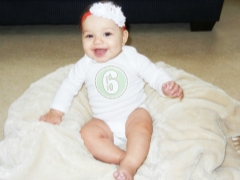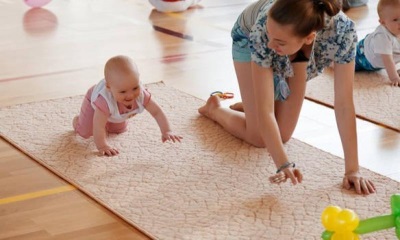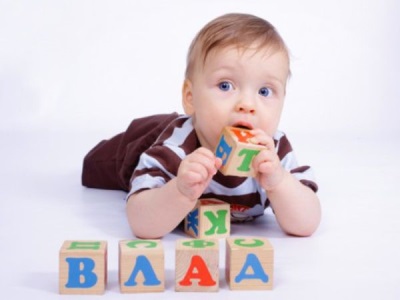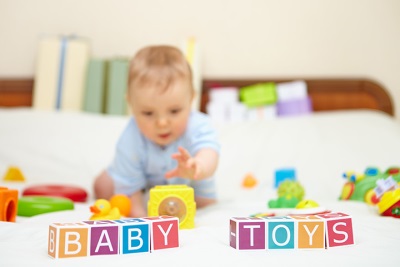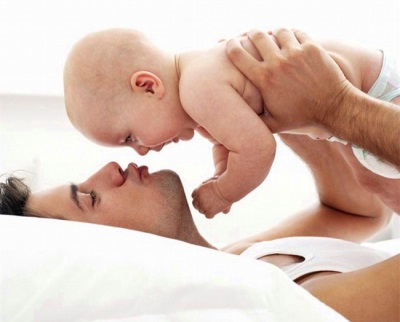Child development at 6 months
The six-month-old baby is very different from the baby, which was just born, both physically and emotionally. What did the tot learn by the age of 6 months, what skills makes parents happy every day and how can adults stimulate the development of babies at this age?
Physiological changes
- The muscles of the back and shoulders to the 6-month-old age has already strengthened so much that the crumb can sit without the presence of outside support. Sitting, the kid keeps balance and freely operates the hands. Also, muscle development is important to start crawling.
- The child rolls freely in any direction and is very mobile, which requires increased attention from adults.
- The vision of 6-month-old children is fully developed and functions as in adults. The child easily watches things that move, as well as the views of other people.
- Many children at this age have their first teeth cut. They appear on the lower jaw. In this regard, the saliva production in a six-month-old baby is increasing.

Physical development
During the sixth month of life, the toddler gains about 650 grams, and the baby grows another 2 centimeters more. By this age, the weight of the crumbs is twice the figure, which was determined immediately after the birth of the baby. The chest in the sixth month is increased by 1-1.5 centimeters, and the head circumference - by 0.5-1 centimeter.
Each child develops at his own pace, however, in order to understand whether the baby is growing normally, the limits of the norm were determined, as well as the average indicators of the physical development of children of a certain age. Knowing about them, parents can identify if there are any problems with the growth of the baby and whether the child needs additional pediatric consultation. The main indicators for 6-month-old children are presented in the table:
Indicator | 6 month average | Boys in 6-7 months | Girls 6-7 months |
Weight | 7300-7900 g | 6400-9800 g | 5700-9300 g |
Growth | 65.7-67.6 cm | 63.3-71.9 cm | 61.2-70.3 cm |
Head circumference | 42.2-43.3 cm | 40.9-45.8 cm | 39.6-44.8 cm |
Chest circumference | 43.7-44.5 cm | 41.4-47.6 cm | 41.6-45.8 cm |
What baby can?
The baby has already learned to sit without support for six months. However, many children of this age still can not sit on their own. In the kitchen, the baby can already sit in a special chair, watching her mother prepare dinner.
Crawling becomes another very useful skill of a half year old baby. Some babies actively move on bellies on the tummy, helping themselves with their legs, while others get on all fours.
Not less important skills of a 6-month-old baby:
- The baby also begins to stand on its feet, clutching its hands to some kind of solid support. If an adult takes the crumb by both hands and pulls it up a little, he will see the baby stand on straight legs. Moreover, holding the toddler's chest, you can see how the crumb begins to cross legs.
- The child perfectly manages his hands. If the crumbs are interested in any object, the baby will reach out to him. The child who has dropped out of a hand with the child with ease will lift. Holding the object in one hand, the toddler deftly can shift it to another pen.
- The child can already bind his actions and results, for example, if you pull your hand, the toy with a bell will ring, and if you throw it out of the bed, it will fall to the floor.
- The crumb still studies subjects, trying on "tooth". This is an absolutely normal way to learn about the world for half year old children, which cannot be perceived as a bad habit.
- The child already knows his name very well and responds with a smile and animation. Baby carefully listens to the speech of an adult. If you tell him about any familiar large object, the crumb will immediately find it with his eyes.
- The speech of a 6 month old baby is changing. A crumb connects sounds in syllables, but so far they do not carry any semantic meaning. The number of pronounced syllables becomes more every day. This speech is called babble.
- The karapuz of 6 months treats strangers with caution and is very wary. At the same time, half-year-old babies are more supportive of other children. They watch them and often copy their actions. With loved ones, the baby can show tenderness, for example, cuddle up to mom.
- Six-month-old children can already remove food from a spoon with their lips.
How to evaluate the development of the baby in 6 months, see video councils for moms of the SuperMam channel.
No need to worry if your 6-month-old baby has not yet learned to babble, sit without support, reach out to the desired object, stand on its feet, distinguish between familiar and unfamiliar people, or eat solid food - all these skills may appear a little later.
But there are skills, the absence of which the baby should be alerted. These include:
- Coups from the abdomen and back and back.
- Raising the upper torso in the prone position.
- The ability to sit with support.
- Turns of the head to view the world around us.
- The goo
- The study of toys with the help of hands (the baby knocks them, shakes, gropes).
- Examining various subjects with the help of the mouth.
The fact that the baby should be able to 6 months, see the video of Larisa Sviridova.
Classes for development
- Let the baby spend a lot of time on the floor. Spread various toys around the crumbs so that the baby wants to crawl over to them.
- When the child is sitting on the floor, sit opposite and roll the ball from you to the baby and back.
- For the development of coordination, dad can roll the child on his shoulders, and mom - sit the baby on his leg and shake slowly and then quickly.
- To store your baby's toys, purchase small boxes. The crumb will enthusiastically dig into them, going over toys.
- Every day, massage your fingers for 2-3 minutes. Knead each finger in turn, and also easily sip it.
- Let the child play with molds or boxes of different sizes. Crumb will also like toys, in which the figures can move in a spiral, tweeters, dolls.
- Hold a child in the hands of two toys and offer a third. First, the crumb wants to grab it, not letting go of the existing toys, but then he will understand that one of the toys will have to be put.
- Make a few bags for the baby, in which there will be different fillers - buttons, beans, millet, smooth pebbles and others.
- For the best development of the speech of the baby constantly communicate with the crumbs when he makes sounds. Answer the baby, repeating his babble, and also voice all your actions. At the same time, talk about yourself "mom" so that the baby begins to relate this word to you ("now mom will give you a bell"). Similarly, teach the crumb to the connection of the word "dad" with his father.
- Show baby books with bright pictures. At the same time talk about what they have drawn. Well, if in such books there will be short rhymes with repeated phrases.
- Walking with a baby in the park, show the kid leaves, trees, grass. If you go with a 6-month-old baby to the store, do not miss the opportunity to show off the crumbs of fruits, vegetables, dishes and many other items, voicing their names.
- Tie a balloon to the pram and watch the baby pull the rope.
- Still interesting to the baby are such games as “ku-ku”, “ladies” and “forty-crow”.
- Diversify baby bathing using different toys. Let ships, plastic dishes, rubber toys float near the bathing baby.
- Invite families with children to visit, so that the crumb learns to communicate with another child.
Play with the child in the games shown in the TV program "Mother's school" channel "TSV".
Care
For six months, the daily baby care procedures continue to be:
- Hygiene procedures - washing, washing, cutting nails, combing, cleaning the ears and nose. Brushing their teeth is added to them, even if the first tooth has not yet appeared. It is recommended to clean the mouth of the baby with a special rubber brush.
- Tempering procedures. At 6 months of age, these are air and sun baths, walking on a wet towel, wiping off.
- Bathing. A bath not only helps the baby to relax before a night's sleep, but also brings a lot of positive emotions.
- Massage and gymnastics. Stroking, rubbing, passive and active exercises help the body of the toddler to become stronger.
Do not forget about the safety of a child of six months. The baby can roll over at any time, so leave it on an elevation unattended is unacceptable. A child who has begun to crawl is able to get to detergents, outlets and other dangerous things.
You can get acquainted with the technique of fortifying massage by watching the video of Nikolai Nikonov - the leading doctor and masseur of Russia.
Daily regime
Having a daily regimen is very important for the development of the child’s nervous system. Crumbs at the age of six months require about 15-16 hours of sleep per day. Approximately 9-10 hours, the child sleeps at night, and the rest of the time is divided into 3 daytime sleep, the duration of which is up to 1.5-2 hours. Try to lay the baby at the same time every day, and waking up a 6-month-old baby in the morning is not worth it.
Walking at 6 months of age is still held twice a day due to weather conditions. Long festivities are possible in good weather, and if there is a strong wind, rain or air temperature below -10 outside, you should refrain from a walk. During walks, the baby is now not only sleeping, but also studying the world around with interest.
Breastfeeding varies slightly at six months of age. Sucking at night is shifted to the last hours before waking up. At the same time, in the first half of the day, the crumb is applied to the breast less frequently, and in the afternoon, the attachment becomes more frequent.
A six-month-old baby who had previously received only breast milk, begin to introduce lure, choosing for him vegetables in the form of mashed potatoes or porridge. The next kind of complementary foods for 6-month crumbs will be fruit. A new dish is offered in small portions in the morning, watching the state and reaction of the infant's body.
Babies on artificial feeding eat 5 times a day. The total amount of food for a baby of 6 months is calculated by dividing the weight of the child by 8. On average, a child of this age eats 1000-1100 ml of food per day. This volume is divided by the number of feedings, so an approximate portion of food for one meal of a six-month baby will be 200-220 ml. The menu of complementary foods for children of artifacts includes vegetables, cereals, fruits, butter and vegetable oil.
Typical day
Days with six-month babies are interesting and entertaining. And although the mode of each of the semi-annual karapuz is individual and depends on the biological rhythms of the infant, we offer an approximate version of the daily regimen for a 6-month-old baby:
6: 30 | Sifting and first feeding (baby gets breast milk or formula), hygienic procedures. |
8: 00 | Laying down on the first day nap. |
10: 00 | Sifting and second feeding (babies breastfeeding give porridge, and babies-artificials add oil to it), the waking period. |
11: 30 | Walk, during which the child usually has a second day's sleep in the fresh air. |
13: 30 | Returning home, the third feeding (the breastfed baby gets vegetable puree, and the baby-baby is fed with vegetable oil puree). |
14: 00 | The period of wakefulness and educational games. |
15: 30 | Walk, during which usually is the third day nap in the open air. |
17: 00 | Return home, fourth feeding (it includes fruit puree and breast milk or a mixture). |
17: 30 | Period of wakefulness. |
20: 00 | Bathing, fifth feeding (breast milk or formula), laying down at night. |
Night time | Infant breastfeeding babies are applied to the breast several times; children with artificial children usually do not wake up for feeding. |
Do not forget that the child first of all needs the love and support of parents.
Frequent problems
- Discomfort from teething. In babies, the gums swell and itch, which interferes with the crumbs and makes the behavior of the baby cranky. In some karapuz, the appearance of teeth is accompanied by fever, loose stools and other negative symptoms.
- Frequent waking at night. A better night’s sleep will be aided by bathing before laying down for the night and feeding afterwards. Also, make sure that at least 4 hours pass between the third day sleep and sleep at night.
- Injuries. The six month old baby is very active, so it is important for parents to prevent any risks of getting injuries, which are enough at this age. A crumb can roll over on the beds and fall off of it, do not hold onto the furniture when you get up, crawl and bump into the sharp edge of the furniture or the drawer of the dresser. It is also important not to forget about the risk of pinching your fingers, opening the drawers of the cabinets, trying out the taste of detergents, getting into the trash can, choking on small details of the toy.
Spend lessons with the baby on the method of “Little Leonardo” shown in the video of Olga Teplyakova, an expert in intellectual development.
